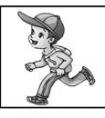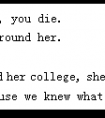baby car enoughleaveanythinguspoor rich remember surprised took wheneverOne a snowy evening, a rich lady was standing by the road. She was very worried. Her 1h-八年级英语
题文
The lady thought, “Is the man going to help me? He looks very cold and hungry. ”But to her 2 , he stopped and said with a smile, “What’s wrong, madam?” The lady told him what was happening. After forty minutes, the car was at last fixed by Robert. The lady wanted to pay him. “No, that’s 3 , madam.” he said, “I was just helping someone in need. If you really want to pay me back, I hope you 4 see someone in trouble, please give him a hand.” A few minutes later, the lady saw a shabby house by the road. She 5 Robert’s words, so she stopped. The hostess warmly asked her in. The lady could see that was a 6 family and they needed help. When the hostess was making tea in the kitchen, the lady 7 500 dollars on the table and went away quietly. Robert came home later than before, thinking how hard their life was. Their 8 was to be born the next month but there wasn’t 9 money. His wife went up to him, gave him a kiss and said softly, “Don’t worry, dear! Everything’s going to be all right. A stranger has helped us out. ” Let’s always be ready to help others because helping others is helping 10 . |
答案
小题1:car 小题2:surprise 小题3:nothing 小题4:whenever 小题5:remembered 小题6:poor 小题7:left 小题8:baby 小题9:enough 小题10:ourselves |
小题1:break down可以做“(汽车)抛锚”所以选car。 小题2:to her surprise是“使她惊讶的是” 小题3:that’s nothing“没什么”,符合上文的:The lady wanted to pay him.女士想要感谢他。 小题4:whenever可以引导时间状语从句,意思是:每当你看到有困难的人, 小题5:remember one’s words“想起某人的话”,这里用过去时。 小题6:从后面的they needed help.说明是a poor family。 小题7:leave 500 dollars on the table“在桌上留了500美元”用过去时left。 小题8:后面的was to be born“将要出生”,说明填“baby” 小题9:there wasn’t enough money“钱不够”。 小题10:helping others is helping ourselves“帮助别人就是帮助自己” |
据专家权威分析,试题“baby car enoughleaveanythinguspoor rich remember surprised t..”主要考查你对 连词成句 等考点的理解。关于这些考点的“档案”如下:
连词成句
考点名称:连词成句
- 连词成句:
即是把错乱排列的词语根据语法或句法特点排列组合成为句式整齐,内容恰当,语气流畅的句子的方法。
他基本的要求是句子完整和流畅没有语法错误,更不要有语病。 连词成句题做题技巧:
首先强调第一个单词的第一个字母要大写,其次句子的最后要有标点符号。然后分句型来做:
1. 陈述句的时候,先找主语,然后找动词,再找其他,记得时间和地点是放在后面的。
2. 疑问句时,有疑问词的情况下找疑问词,然后找助动词,找主语,找其他。没有疑问词的情况下,就找助动词/be动词,再找主语,找其他。
3. 做这一类型的题目时,学生要有一定的基础,会认读单词,熟悉基本句型。
具体可以分一下几步来完成:
一、看清标点符号
1.如果是句号,则是陈述语句。陈述句的基本结构就是主语+谓语+宾语而构成的。
2.如果是问号,则是疑问语句。要先看是特殊疑问句还是由情态动词引导的疑问句。
①如果有where 、what、how等疑问词,那么它就是特殊疑问句,就要把疑问词where 、 what、 how 等放在一句话的最前面,它后面紧接的是be动词也就是我们学习过的am、is、are三个单词。
②如果题目中有can、 may、shall、would等情态动词,那么它就是由情态动词引导的疑问句。
例如:“have I a may new bike (?)” 。这道题目中有一个情态动词may,很显然这就是由情态动词may引导的疑问句。那么我们就要把may放在句子的最前面,后面紧接的就是这句话的主语(主语往往是人或者物)。
很快我们就能写出这句话的前半部分“May I have …”很显然,还剩下的几个单词可以构成一个词组“a new bike”,那么将整句话连起来就是“May I have a new bike ?”(我可以拥有一个新的自行车吗?)。
同样其他的句子,例如:由can 、would、shall等情态动词引导的句子也是这样的方法可以完成。
③如果题目中没有任何的特殊疑问词,也没有任何情态动词,那么它就是我们最最熟悉的一般疑问句了。
例如:“you a are student(?)”。很显然是一个疑问句,而且没有任何特殊疑问词。所以这是一句一般疑问句,一般疑问句的基本准则就是疑问词是be动词(am /is/are),而且要把它们放在句子的最前面。
通过观察我们看到题目中有一个be动词(are),所以这句话就很容易连到“Are you a student ?”(你是一个学生吗?)。
这样的题目还可以先将它当作一般陈述句来做,然后再由陈述句改成一般疑问句。
例如“you a are student(?)”这题还可以先将它写成一般陈述句的形式“You are a student.”。
然后将它写成一般疑问句,即是将这句话的主语和谓语(be动词)对调,得到“Are you a student?”,这样这句话也就完成了。
3.如果是感叹号,则是感叹语句。
①由what引导的感叹句。
我们知道有what引导的感叹句,其基本结构是What + a + adj. + n.。
例如:“What a nice book !”(多漂亮的一本书啊!)
② 由how引导的感叹句。
与what引导的感叹句相似,how引导的感叹句的结构是“How + adj.( +n. /名词短语 + be动词 )!”。二、注意特殊句型
还有一些连词成句的题目看上去似乎是无规律可循。
有这样一个题目:“to time to go it’s school (.)” 这样的题目就要求学生对有些句型的熟练掌握。
这条题目考的是学生对句型“it’s time to do sth.” 的运用和词组“go to school(去上学)”,这是一条交际运用题。
- 最新内容
- 相关内容
- 网友推荐
- 图文推荐
| [家长教育] 孩子为什么会和父母感情疏离? (2019-07-14) |
| [教师分享] 给远方姐姐的一封信 (2018-11-07) |
| [教师分享] 伸缩门 (2018-11-07) |
| [教师分享] 回家乡 (2018-11-07) |
| [教师分享] 是风味也是人间 (2018-11-07) |
| [教师分享] 一句格言的启示 (2018-11-07) |
| [教师分享] 无规矩不成方圆 (2018-11-07) |
| [教师分享] 第十届全国教育名家论坛有感(二) (2018-11-07) |
| [教师分享] 贪玩的小狗 (2018-11-07) |
| [教师分享] 未命名文章 (2018-11-07) |






